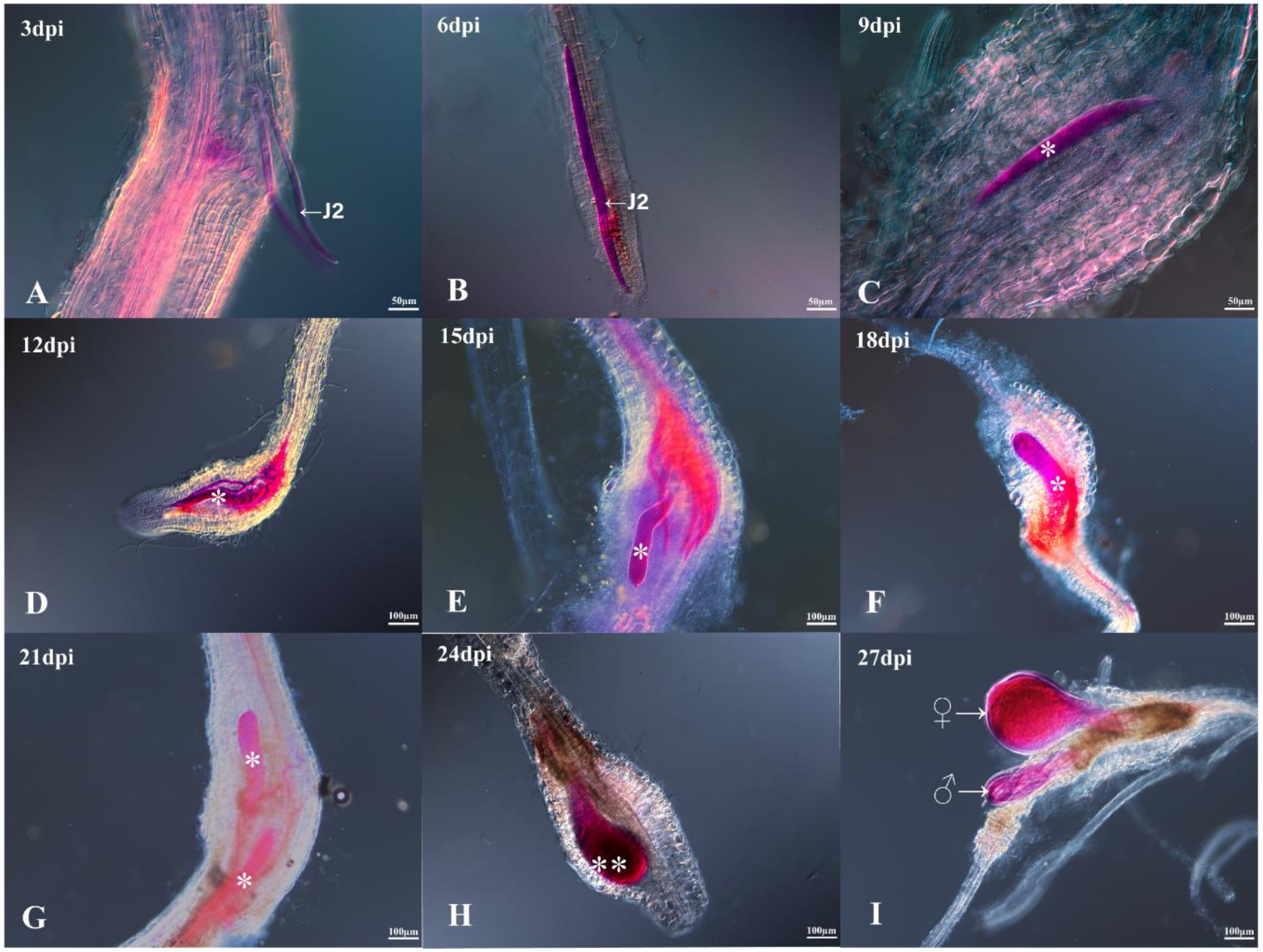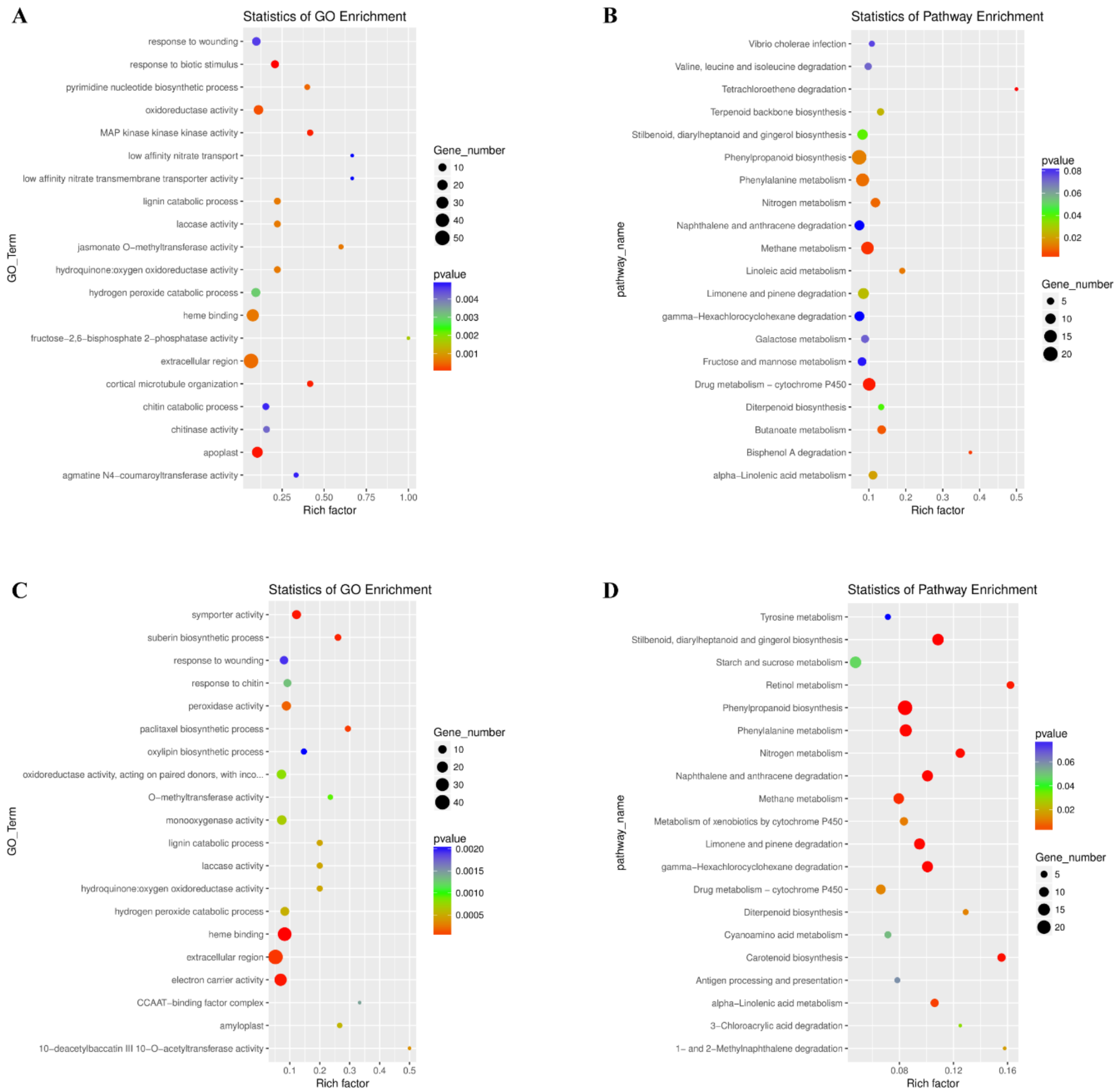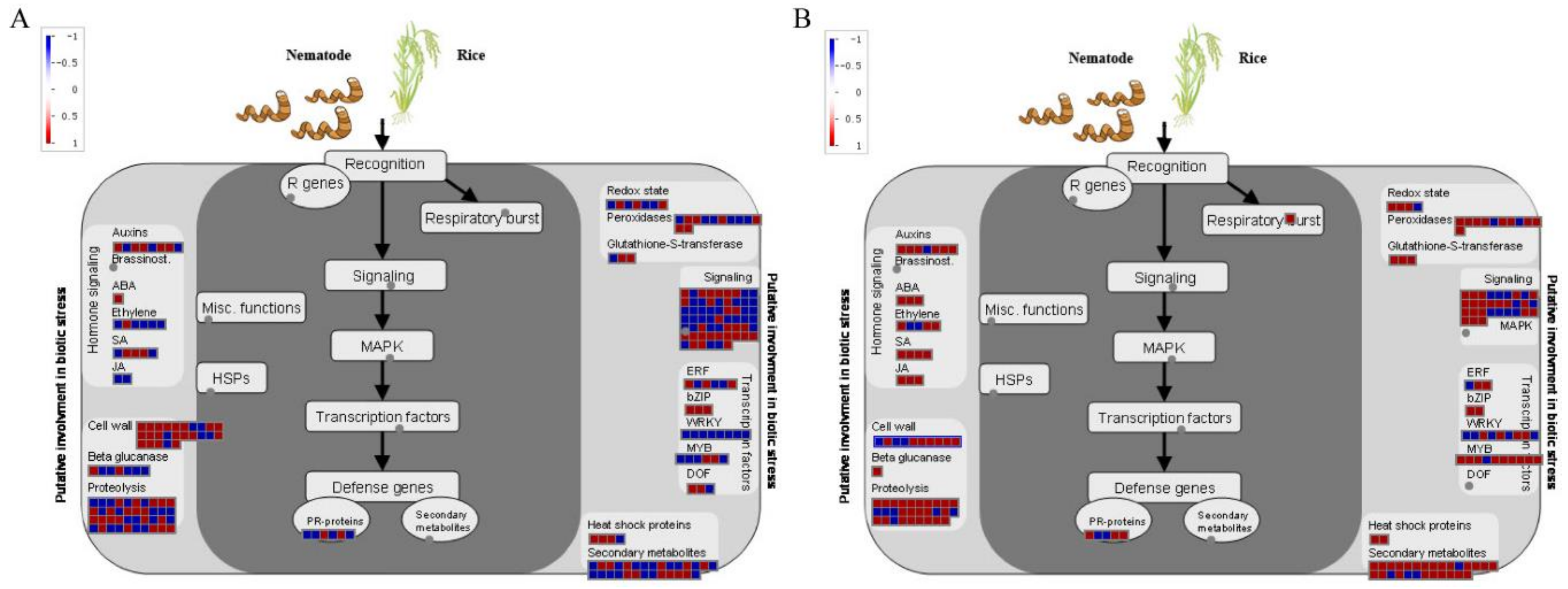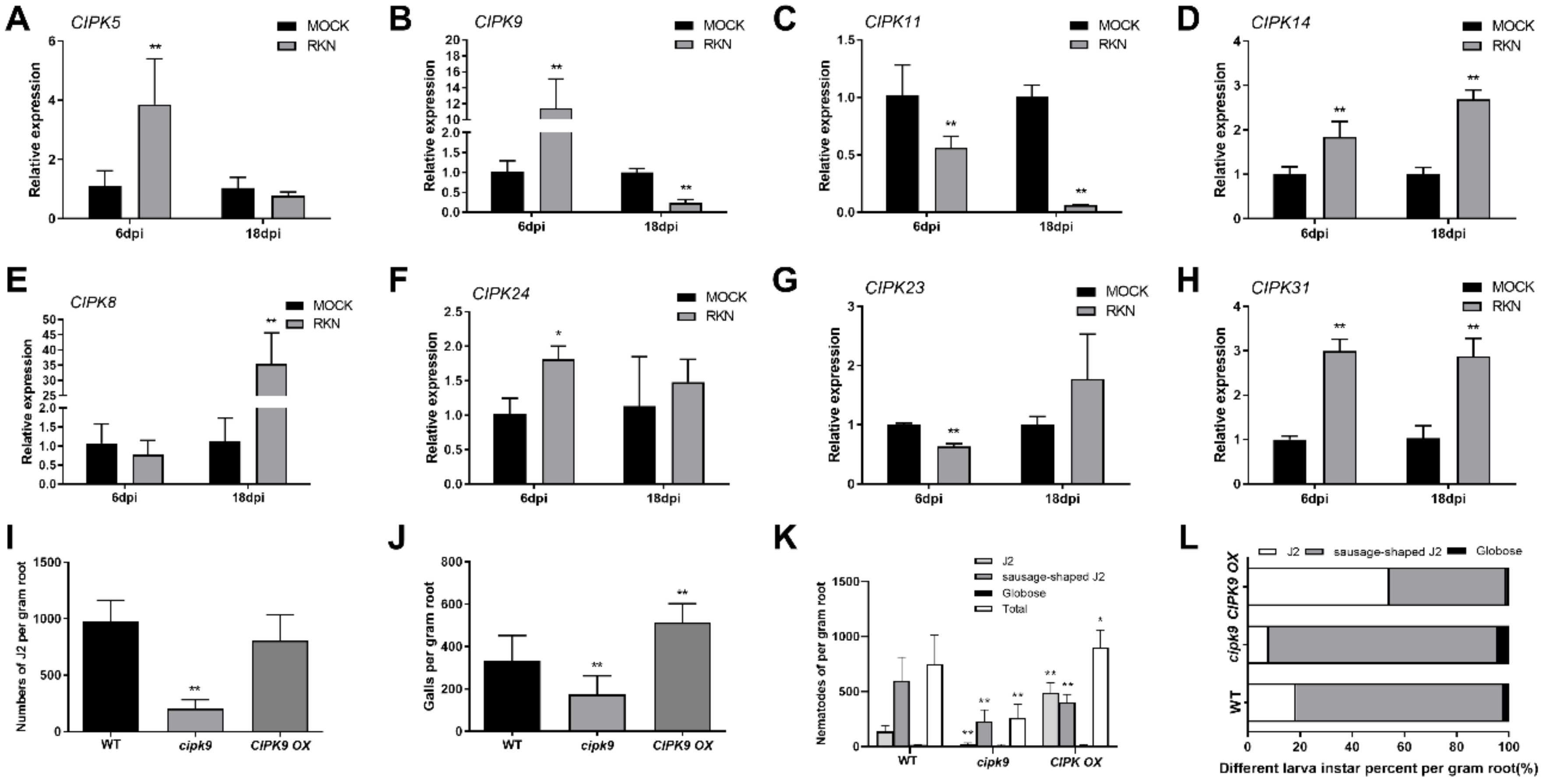Transcriptome Analysis of Rice Roots in Response to Root-Knot Nematode Infection
Abstract
1. Introduction
2. Results
2.1. Analysis of RKN Invasion and Development in Rice Roots
2.2. Transcriptome Analysis to Identify Differentially Expressed Genes upon RKN Infection
2.3. CIPK Genes in Rice Response to RKN
2.4. BR Signaling Regulation of RKN Invasion and Development
2.5. Activation of Ethylene Signaling during RKN Invasion and Development
3. Discussion
4. Materials and Methods
4.1. Nematode Culture
4.2. Plant Growth and Nematode Inoculation Assay
4.3. RNA Extraction, Library Preparation, and Sequencing
4.4. Differential Gene Expression Analysis
4.5. qRT-PCR Analysis
4.6. Statistical Analysis
Supplementary Materials
Author Contributions
Funding
Conflicts of Interest
Abbreviations
| RKNs | root-knot nematode |
| BR | brassinosteroid |
| J2 | second-stage infective juveniles |
| GO | Gene Ontology |
| KEGG | Kyoto Encyclopedia of Genes and Genomes |
| dpi | days post inoculation |
| DEGs | differentially expressed genes |
| qRT-PCR | quantitative real-time PCR |
References
- FAOSTAT Food and Agriculture Organization of the United Nations. FAOSTAT Database. 2002. Available online: http://www.fao.org/faostat/en/#data/QC (accessed on 30 May 2019).
- Castagnone-Sereno, P.; Danchin, E.G.; Perfus-Barbeoch, L.; Abad, P. Diversity and evolution of root-knot nematodes, genus Meloidogyne: New insights from the genomic era. Annu. Rev. Phytopathol. 2013, 51, 203–220. [Google Scholar] [CrossRef]
- Bridge, J.; Starr, J. Plant Nematodes of Agricultural Importance Acolor Handbook; Academic Press: San Diego, CA, USA, 2007; pp. 77–78. [Google Scholar] [CrossRef]
- Dutta, T.K.; Ganguly, A.K.; Gaur, H.S. Global status of rice root-knot nematode, Meloidogyne graminicola. Afr. J. Microbiol. Res. 2012, 6, 6016–6021. [Google Scholar]
- Williamson, V.M.; Gleason, C.A. Plant-nematode interactions. Curr. Opin. Plant Biol. 2003, 6, 327–333. [Google Scholar]
- Chitwood, D.J. Research on plant-parasitic nematode biology conducted by the united states department of agriculture-agricultural research service. Pest. Manag. Sci. 2003, 59, 748–753. [Google Scholar] [CrossRef]
- Bird, D.M.; Opperman, C.H.; Williamson, V.M. Plant Infection by Root-Knot Nematode. Cell Biology of Plant Nematode Parasitism. Plant Cell Monogr. 1970, 15, 1–13. [Google Scholar] [CrossRef]
- Berg, R.H.; Taylor, C. Plant Infection by Root-Knot Nematode of Cell Biology of Plant Nematode Parasitism; Springer: Berlin/Heidelberg, Germany, 2009; p. 113. [Google Scholar] [CrossRef]
- Jones, J.; Gheysen, G.; Fenoll, C. Genomics and Molecular Genetics of Plant–Nematode Interactions; Springer: Dordrecht, The Netherlands, 2011. [Google Scholar] [CrossRef]
- Bridge, J.P.R.; Peng, D. Nematode parasites of rice. In Plant Parasitic Nematodes in Subtropical and Tropical Agriculture; Luc, M., Sikora, R.A., Bridge, J., Eds.; CABI: Wallingford, UK, 2005. [Google Scholar] [CrossRef]
- Kyndt, T.; Fernandez, D.; Gheysen, G. Plant-parasitic nematode infections in rice: molecular and cellular insights. Annu. Rev. Phytopathol. 2014, 52, 135–153. [Google Scholar] [CrossRef]
- Hewezi, T.; Baum, T.J. Manipulation of plant cells by cyst and root-knot nematode effectors. MPMI 2013, 26, 9–16. [Google Scholar] [CrossRef]
- Bari, R.; Jones, J.D. Role of plant hormones in plant defence responses. Plant Mol. Biol. 2009, 69, 473–488. [Google Scholar] [CrossRef]
- De Vleesschauwer, D.; Gheysen, G.; Hofte, M. Hormone defense networking in rice: tales from a different world. Trends Plant Sci. 2013, 18, 555–565. [Google Scholar] [CrossRef]
- De Vleesschauwer, D.; Xu, J.; Hofte, M. Making sense of hormone-mediated defense networking: from rice to Arabidopsis. Front. Plant Sci. 2014, 5, 611. [Google Scholar] [CrossRef]
- Grant, M.R.; Jones, J.D. Hormone (dis)harmony moulds plant health and disease. Science 2009, 324, 750–752. [Google Scholar] [CrossRef]
- Nahar, K.; Kyndt, T.; Hause, B.; Hofte, M.; Gheysen, G. Brassinosteroids suppress rice defense against root-knot nematodes through antagonism with the jasmonate pathway. MPMI 2013, 26, 106–115. [Google Scholar] [CrossRef]
- Spoel, S.H.; Dong, X. Making sense of hormone crosstalk during plant immune responses. Cell Host Microbe 2008, 3, 348–351. [Google Scholar] [CrossRef]
- Gheysen, G.; Mitchum, M.G. How nematodes manipulate plant development pathways for infection. Curr. Opin. Plant Biol. 2011, 14, 415–421. [Google Scholar] [CrossRef]
- Ton, J.; Van Pelt, J.A.; Van Loon, L.C.; Pieterse, C.M. Differential effectiveness of salicylate-dependent and jasmonate/ethylene-dependent induced resistance in Arabidopsis. MPMI 2002, 15, 27–34. [Google Scholar] [CrossRef]
- Williamson, V.M. Plant nematode resistance genes. Curr. Opin. Plant Biol. 1999, 2, 327–331. [Google Scholar] [CrossRef]
- Williamson, V.M.; Kumar, A. Nematode resistance in plants: The battle underground. TIG 2006, 22, 396–403. [Google Scholar] [CrossRef]
- Lorieux, M.; Reversat, G.; Garcia Diaz, S.X.; Denance, C.; Jouvenet, N.; Ghesquiere, A. Linkage mapping of Hsa-1(Og), a resistance gene of African rice to the cyst nematode, Heterodera sacchari. TAG. Theoretical and applied genetics. Theor. Appl. Genet. 2003, 107, 691–696. [Google Scholar] [CrossRef]
- Wan, J.; Vuong, T.; Jiao, Y.; Joshi, T.; Zhang, H.; Nguyen, H.T. Whole-genome gene expression profiling revealed genes and pathways potentially involved in regulating interactions of soybean with cyst nematode (Heterodera glycines Ichinohe). BMC Genom. 2015, 16, 148. [Google Scholar] [CrossRef]
- Barcala, M.; Garcia, A.; Cabrera, J.; Casson, S.; Lindsey, K.; Favery, B.; García-Casado, G.; Solano, R.; Fenoll, C.; Escobar, C. Early transcriptomic events in microdissected Arabidopsis nematode-induced giant cells. Plant J. 2010, 61, 698–712. [Google Scholar] [CrossRef]
- Caillaud, M.C.; Dubreuil, G.; Quentin, M.; Perfus-Barbeoch, L.; Lecomte, P.; de Almeida Engler, J. Root-knot nematodes manipulate plant cell functions during a compatible interaction. Plant Physiol. 2008, 165, 104–113. [Google Scholar] [CrossRef]
- Nguyen, P.V.; Bellafiore, S.; Petitot, A.S.; Haidar, R.; Bak, A.; Fernandez, D. Meloidogyne incognita—Rrice (Oryza sativa) interaction: A new model system to study plant-root-knot nematode interactions in monocotyledons. Rice 2014, 7, 23. [Google Scholar] [CrossRef]
- Delteil, A.; Zhang, J.; Lessard, P.; Morel, J.-B. Potential candidate genes for improving rice disease resistance. Rice 2010, 3, 56. [Google Scholar] [CrossRef]
- Kyndt, T.; Zemene, H.Y.; Haeck, A.; Singh, R.; De Vleesschauwer, D.; Gheysen, G. Below-Ground Attack by the Root Knot Nematode Meloidogyne graminicola Predisposes Rice to Blast Disease. MPMI 2017, 30, 255–266. [Google Scholar] [CrossRef]
- Gao, Y.; Zhang, C.; Han, X.; Wang, Z.Y.; Ma, L.; Xuan, Y.H. Inhibition of OsSWEET11 function in mesophyll cells improves resistance of rice to sheath blight disease. Mol. Plant Pathol. 2018, 19, 2149–2161. [Google Scholar] [CrossRef]
- Yuan, P.; Zhang, C.; Wang, Z.Y.; Zhu, X.F.; Xuan, Y.H. RAVL1 Activates Brassinosteroids and Ethylene Signaling to Modulate Response to Sheath Blight Disease in Rice. Phytopathology 2018, 108, 1104–1113. [Google Scholar] [CrossRef]
- Chen, Q.; Peng, D. Nematode Chitin and Application. Adv. Exp. Med. Biol. 2019, 1142, 209–219. [Google Scholar] [CrossRef]
- McNeece, B.T.; Sharma, K.; Lawrence, G.W.; Lawrence, K.S.; Klink, V.P. The mitogen activated protein kinase (MAPK) gene family functions as a cohort during the Glycine max defense response to Heterodera glycines. Plant Physiol. Biochem. 2019, 137, 25–41. [Google Scholar] [CrossRef]
- Kyndt, T.; Denil, S.; Haegeman, A.; Trooskens, G.; Bauters, L.; Gheysen, G. Transcriptional reprogramming by root knot and migratory nematode infection in rice. N. Phytol. 2012, 196, 887–900. [Google Scholar] [CrossRef]
- Nahar, K.; Kyndt, T.; De Vleesschauwer, D.; Hofte, M.; Gheysen, G. The jasmonate pathway is a key player in systemically induced defense against root knot nematodes in rice. Plant Physiol. 2011, 157, 305–316. [Google Scholar] [CrossRef]
- Song, L.X.; Xu, X.C.; Wang, F.N.; Wang, Y.; Xia, X.J.; Yu, J.Q. Brassinosteroids act as a positive regulator for resistance against root-knot nematode involving RESPIRATORY BURST OXIDASE HOMOLOG-dependent activation of MAPKs in tomato. Plant Cell Environ. 2018, 41, 1113–1125. [Google Scholar] [CrossRef]
- Zhu, X.F.; Liu, Y.; Gai, X.T.; Zhou, Y.; Xia, Z.Y.; Xuan, Y.H. SNARE proteins SYP22 and VAMP727 negatively regulate plant defense. Plant Signal. Behav. 2019, 14, 1610300. [Google Scholar] [CrossRef]
- Zhang, H.; Kjemtrup-Lovelace, S.; Li, C.; Luo, Y.; Chen, L.P.; Song, B.H. Comparative RNA-Seq Analysis Uncovers a Complex Regulatory Network for Soybean Cyst Nematode Resistance in Wild Soybean (Glycine soja). Sci. Rep. 2017, 7, 9699. [Google Scholar] [CrossRef]
- De la Torre, F.; Gutierrez-Beltran, E.; Pareja-Jaime, Y.; Chakravarthy, S.; Martin, G.B.; del Pozo, O. The tomato calcium sensor Cbl10 and its interacting protein kinase Cipk6 define a signaling pathway in plant immunity. Plant Cell 2013, 25, 2748–2764. [Google Scholar] [CrossRef]
- Branch, C.; Hwang, C.-F.; Navarre, D.A.; Williamson, V.M. Salicylic acid is part of the Mi-1-mediated defense response to root-knot nematode in tomato. MPMI 2004, 17, 351–356. [Google Scholar] [CrossRef]
- Xuan, Y.H.; Kumar, V.; Han, X.; Kim, S.H.; Jeong, J.H.; Han, C.-D. CBL-INTERACTING PROTEIN KINASE 9 regulates ammonium-dependent root growth downstream of IDD10 in rice (Oryza sativa). Ann. Bot. 2019, 124, 947–960. [Google Scholar] [CrossRef]
- Jeong, D.H.; An, S.; Kang, H.G.; Moon, S.; Han, J.J.; Park, S.; Lee, H.S.; An, K.; An, G. T-DNA insertional mutagenesis foractivation tagging in rice. Plant Physiol. 2002, 130, 1636–1644. [Google Scholar]
- Hong, Z.; Ueguchi-Tanaka, M.; Umemura, K.; Uozu, S.; Fujioka, S.; Takatsuto, S.; Yoshida, S.; Ashikari, M.; Kitano, H.; Matsuoka, M. A rice brassinosteroid-deficient mutant, ebisu dwarf (d2), is caused by a loss of function of a new member of cytochrome P450. Plant Cell 2003, 15, 2900–2910. [Google Scholar]
- Ma, B.; Yin, C.C.; He, S.J.; Lu, X.; Zhang, W.K.; Lu, T.G.; Chen, S.Y. Ethylene-induced inhibition of root growth requires abscisic acid function in rice (Oryza sativa L.) seedlings. PLoS Genet. 2014, 10, e1004701. [Google Scholar]
- Bybd, D., Jr.; Kirkpatrick, T.; Barker, K. An improved technique for clearing and staining plant tissues for detection of nematodes. J. Nematol. 1983, 15, 142. [Google Scholar] [CrossRef]
- Thies, J.A.; Merrill, S.B.; Corley, E.L. Red food coloring stain: New, safer procedures for staining nematodes in roots and egg masses on root surfaces. J. Nematol. 2002, 34, 179. [Google Scholar]
- Trapnell, C.; Hendrickson, D.G.; Sauvageau, M.; Goff, L.; Rinn, J.L.; Pachter, L. Differential analysis of gene regulation at transcript resolution with RNA-seq. Nat. Biotechnol. 2013, 31, 46–53. [Google Scholar]
- Ye, J.; Fang, L.; Zheng, H.; Zhang, Y.; Chen, J.; Wang, J. WEGO: A web tool for plotting GO annotations. Nucleic Acids Res. 2006, 34, W293–W297. [Google Scholar] [CrossRef]
- Dupuy, D.; Bertin, N.; Hidalgo, C.A.; Venkatesan, K.; Tu, D.; Lee, D. Genome-scale analysis of in vivo spatiotemporal promoter activity in Caenorhabditis elegans. Nat. Biotechnol. 2007, 25, 663–668. [Google Scholar] [CrossRef]
- Livak, K.J.; Schmittgen, T.D. Analysis of relative gene expression data using real-time quantitative PCR and the 2− ΔΔCT method. Methods 2001, 25, 402–408. [Google Scholar] [CrossRef]







© 2020 by the authors. Licensee MDPI, Basel, Switzerland. This article is an open access article distributed under the terms and conditions of the Creative Commons Attribution (CC BY) license (http://creativecommons.org/licenses/by/4.0/).
Share and Cite
Zhou, Y.; Zhao, D.; Shuang, L.; Xiao, D.; Xuan, Y.; Duan, Y.; Chen, L.; Wang, Y.; Liu, X.; Fan, H.; et al. Transcriptome Analysis of Rice Roots in Response to Root-Knot Nematode Infection. Int. J. Mol. Sci. 2020, 21, 848. https://doi.org/10.3390/ijms21030848
Zhou Y, Zhao D, Shuang L, Xiao D, Xuan Y, Duan Y, Chen L, Wang Y, Liu X, Fan H, et al. Transcriptome Analysis of Rice Roots in Response to Root-Knot Nematode Infection. International Journal of Molecular Sciences. 2020; 21(3):848. https://doi.org/10.3390/ijms21030848
Chicago/Turabian StyleZhou, Yuan, Di Zhao, Li Shuang, Dongxue Xiao, Yuanhu Xuan, Yuxi Duan, Lijie Chen, Yuanyuan Wang, Xiaoyu Liu, Haiyan Fan, and et al. 2020. "Transcriptome Analysis of Rice Roots in Response to Root-Knot Nematode Infection" International Journal of Molecular Sciences 21, no. 3: 848. https://doi.org/10.3390/ijms21030848
APA StyleZhou, Y., Zhao, D., Shuang, L., Xiao, D., Xuan, Y., Duan, Y., Chen, L., Wang, Y., Liu, X., Fan, H., & Zhu, X. (2020). Transcriptome Analysis of Rice Roots in Response to Root-Knot Nematode Infection. International Journal of Molecular Sciences, 21(3), 848. https://doi.org/10.3390/ijms21030848




